Ancient Gods and Modern Men
- By Katharine
- 6 March, 2014
- 7 Comments
I arrived in Kolhapur yesterday, but my laundry did not. This was the first real glitch in my travels. I’m finding that it is the small things that are most difficult to navigate. For example: Why can’t I make outgoing calls on my iPhone with Indian Vodafone SIM card, although I have more than 1,000 rupees left on my balance? Answer: Because I bought the SIM card in Delhi, I have to dial “0” before calls outside Rajasthan State.
I spent Tuesday evening in Pune trying to figure out the bus timetables to Kolhapur. The Cleartrip website showed a 10 a.m. departure for a Neeta bus, but as soon as I clicked to book it, the time changed to 10 p.m. By visiting Neeta’s website, I finally found an 8 a.m. bus and figured out which pickup point was closest to my hotel, but was unable to complete the booking online because “we do not support internationalization” – of credit cards, presumably. Thus I had to cross a nonstop busy road, dodging a million motorcycles, auto-rickshaws, buses, trucks, and cars, find the Raj Travel agency, and then persuade the very nice young woman there that there really was an 8 a.m. departure and that there was, indeed, a pickup point at Pune Railway Station. She hand-wrote my ticket, I paid her, and then I went back to the hotel to pack.
However, my laundry, which I’d asked the hotel to do upon arrival two days earlier and which should have been ready that night, was not delivered by 9:30 p.m., as scheduled. Early yesterday morning the sleepy young man at the front desk informed me, after several phone calls to managers and the laundry service, that it wouldn’t be there until 9 a.m. They promised to deliver the laundry to my hotel here in Kolhapur, but I was highly skeptical. (When I phoned this morning, they informed me it had been sent by courier yesterday and should arrive at my hotel this afternoon.) Fortunately, I still have 4 tops and 3 pairs of pants, but I’m woefully short on socks, undergarments, and dupattas.
I did manage to get an auto-rickshaw (whose driver didn’t speak English) to the Neeta office near Pune Station. After a 10-minute wait, they announced the Kolhapur bus and everyone sprinted across the busy station road to the shuttle van that would take us to the main bus, which would stop on the other side of town, mid-run from Mumbai to Kolhapur. A very nice young man, Hidesh, helped me with my bags. He spoke excellent English. Although he has his degree in pharmacy, he runs an educational consulting firm that helps middle-class Indian students figure out the visa and academic requirements to continue their education in the United States, which he has visited twice. He is also a partner in a pharmacy business; his wife is a chemical engineer who is now staying home with their two young children. But when I mentioned my interest in Indian spirituality, he encouraged me to check out Guru Narayan, who has several ashrams and temples in India, the U.S., and one in Canada as well. Hidesh is typical of the younger Indians I’ve talked with: well-educated, but still believing, in some form, in God and/or the guru.
The real bus – a Volvo A/C 2+2 semi-sleeper with curtained windows and lounge-like seating – was very comfortable and showed a Bollywood film about three male roommates – a young playboy who teaches “hot yoga,” a romantic poet who wins a radio contest, and a divorcing bank manager – who fall in love with young women (the daughter of a former Miss India, the radio DJ who wants to be a Bollywood actress, and a lovely young bank intern) who ultimately don’t return their feelings. But at the end, each of them accidentally runs into someone who looks like a better girlfriend. The whole movie was in Hindi or Marathi (not sure which), without subtitles, but the plot was easy enough to follow. I was helped along by a liberal sprinkling of English phrases like “mid-life crisis,” “Oh my God, sir!” “silicone implants” and “casting couch.” The next movie included the memorable line, “I’ve got an MBA, for God’s sake!” It appeared to be about a young man whose father-in-law always tells him to “Shut up!” at meetings of the family business, so he allies himself with a gang and gets his friends to “kidnap” his wife. We didn’t get to see the end of this one, though.
We climbed steep switchbacks out of Pune to higher and higher levels of the Western Ghats – the stepped plains and mountains above India’s western coast. I kept the curtain pulled when the view was too scary, but when we were on the flats I saw ancient, hand-farmed fields right next to huge, modern industrial buildings. Pune is the headquarters of Tata Motors, which makes most of India’s trucks and buses, and some cars as well. Large factories for machinery lie above the city, scattered seemingly randomly along the highway. The bus stopped half-way at a roadside “hotel” for a tea break, and Hidesh bought me a tiny, 10-rupee cup of masala chai. The sweet, spicy tea made with boiled skim milk is excellent everywhere, and also safe to drink. I couldn’t bring myself to use the Indian squat toilets – there was nowhere to hang my fanny pack – but had drunk virtually nothing all morning, so made it safely to Kolhapur without exploding.
At Kolhapur Station, I hired an auto-rickshaw to take me to my hotel. The auto-rickshaw drivers rarely speak more than a word or two of English, none of them particularly useful, so I showed him the address and then, as I wasn’t sure he could read, either, read it aloud to him several times. As is typical here, he conferred with about a half-dozen other drivers and bystanders, all of whom peered at my paper, and discussed it with many gestures before arriving at a consensus and telling him where to go. Similarly, when we got close, my driver stopped to ask someone else for specifics. Addresses here often include “Opp.” (opposite) or “Nr.” (near to) various landmarks. For example, the Neeta bus stop in Pune was “Opp. S. T. Stand” (the government bus station) and my hotel in Kolhapur is “Nr. Bahar Basant Theater.” It’s a good thing that, during the Intrepid tour, I got used to riding in auto-rickshaws. They are the best way to get around because they are always available, whereas in Pune I was told I’d have to wait half an hour or an hour for a taxi. They are also much cheaper – it cost me less than $3 to go from one side of Pune to the other, and less than $.50 to go to the Mahalaxmi Temple in Kolhapur yesterday.
After an excellent lunch at my hotel, I met with Girish Phonde, a youth organizer, and Shivaji Shinde, an older gentleman who spoke only Marathi. We had chai and coffee on the hotel lawn in the shade and talked about the history of Kolhapur until my eyes glazed over. Mr. Shinde had arranged a tour of the local monastery for Friday. Finally, he went off to work and Girish took me to visit the city’s most famous temple, the Mahalakshmi temple. (Mahalakshmi is also known as Ambabai – not sure why.)

This temple idol of Mahalaxmi is believed to be more than 5,000 years old
The temple is surrounded by stalls selling beautiful garlands and constructions resembling hanging lanterns made of fragrant flowers: lilies, gardenias, marigolds and roses. They also sell coconuts and mini-saris, all of which devotees offer, along with money, to the temple priests at the shrine. Girish told me that the priests turn the more durable offerings back over to the stall holders, to sell again and again to pilgrims. According to a small, illustrated guide to Kolhapur’s significant monuments, the black onyx statue of Mahalaxmi is believed to be at least 5,000 years old, but it’s not clear to me why people worship her. We saw photos of her in different outfits, and Girish told me that on major festival days, people pay 300,000 rupees, or $5,000, for the privilege of dressing her up in a special sari and jewelry. There were golden turtles and other, smaller shrines within the temple, which is an excellent example of South Indian architecture: dark, carved stone topped by brilliantly white shikaras, or conical towers. These are topped with flags and ornamented with fierce black faces representing guard dogs or dragons.
The priests sitting with Mahalaxmi gave me several balls of prasad, or blessed food consisting of ghee, flour and sugar, which we passed out to others upon exiting, as I was nervous of eating them. We saw some newly married couples and their wedding parties processing around and around the temple clock-wise – it’s considered very auspicious to visit a temple within an hour or two of the marriage ceremony. A real mouse ran over the statue of Ganesh, who is often represented with a carved mouse nearby. I also saw my first Shiva lingam and yoni, sacred representations of the male and female sexual organs: the lingam, a small, rounded pillar, sits at the center of a keyhole-type shape, round at the top, with a narrow passageway to one side that is open at the end – a remarkably accurate, if stylized, representation of female reproductive anatomy.
We also visited another, less well-known temple where Girish used to study for his exams during the summer heat. The temples lie right near the Old Palace, with its crumbling walls and huge gates, which now sit over heavily-trafficked roads. Kolhapur is famous for its chappals, or sandals, and we visited a sandal-maker, who offered us fresh, salty lime sodas, but had no chappals big enough for John’s Size 12 feet. We also visited the city library, where we were again offered salty lime sodas while they looked up books on the history of the local monastery. Finally, we walked around the night markets and found a Vodafone booth to check on why I couldn’t make outgoing calls. When I arrived back at the Pavilionn Hotel, a huge wedding celebration was going on next door in the “pavilionn.” I walked around a bit, peeking through large potted plants greenery and past fabric hangings to see the covered chairs, beautifully dressed guests, and the altar platform on which the bride and groom greeted them and had their photos taken with them. Little girls in fancy saris stared at me as they wandered in and out the flower-studded entranceway. Fortunately, it did not rain, as there was no canopy for a “monsoon wedding.” (If you haven’t seen the movie of that name, it’s fabulous!)
Both lunch and dinner at my hotel were excellent, and consisted of well-cooked food. But perhaps one of the lime soda glasses wasn’t clean, as I ended up with some stomach problems last night. Later today we will visit the New Palace and a museum dedicated to Kolhapur’s most famous ruler, a social reformer of the early 18th century called Maharaj Shahu Chhatrapati.
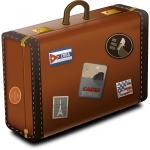
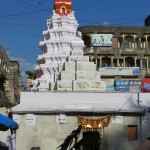
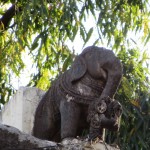
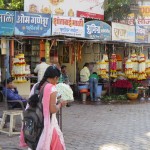
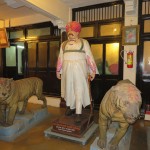
 Copyright © 2024
Copyright © 2024
Hi Katharyn,
I am in awe of your ability to get around in a new country! I can sense the adventurous spirit beneath your words and am enjoying the arm-chair trip to India. It is such an interesting country, a culture that integrates the daily and the spiritual in a way far different from our own. It’s very impressive how you are blogging so faithfully while traveling. Keep those words coming…
Denise
Bonjour friend,
India is like whole Europe.. its like many countries many cultures hundreds of languages. Our each state is drastically different from each other in people, culture, food and history.
Best!
Excellent blog Katharyn,
Would love to read more..
Best regards
Haven’t heard of Mahalaxmi before. Can you expand? Why do people worship him/her? What’s the secret to the 5000 yrs of staying power? I’m not used to seeing ‘xm’ in Indian words – where did that come from? (Sounds Aztec)
Great reading your blog.
Bonjour friend.. Please have a look at the wiki link.. Please let me know if you need any help finding out details of any ancient or cultural places in India.
http://en.wikipedia.org/wiki/Mahalakshmi_Temple,_Kolhapur
Why you’re my travel goddess: “I had to cross a nonstop busy road, dodging a million motorcycles, auto-rickshaws, buses, trucks, and cars, find the Raj Travel agency, and then persuade the very nice young woman there that there really was an 8 a.m. departure and that there was, indeed, a pickup point at Pune Railway Station. She hand-wrote my ticket, I paid her, and then I went back to the hotel to pack.” Look forward to decorating you with fragrant floral garlands when you return!
Nice to read this journey and feel excited being part of it.